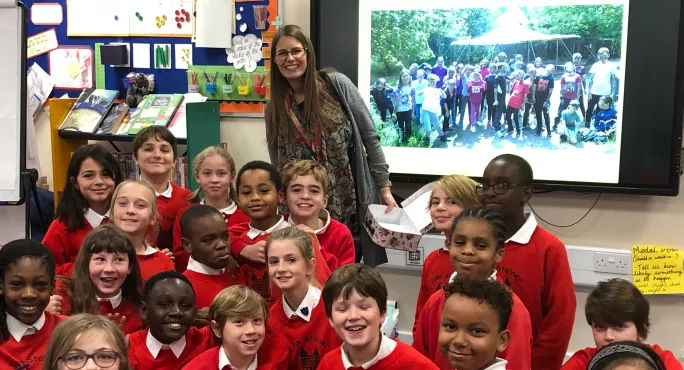- Home
- Welcome to the teacher swap
Welcome to the teacher swap

Imagine this: you’ve just finished setting up your classroom and you pop across to the classroom next door to ask your teaching-neighbour if s/he wants a cuppa before the kids arrive. But instead of the usual face that greets you, there’s a completely different teacher. It’s as if there’s been some sort of horrific secret firing and then rehiring that you knew nothing about.
But it is, in fact, a “teacher swap” in live action.
For one day only, your colleague has swapped places with another teacher in a different school, in a different town.
How do you think that would go? Total chaos? Confused kids? Confused staff?
Well, two schools in the South of England decided to try it out.
Teacher swap
Ryarsh Primary School, a small village school in Kent, swapped staff with John Stainer School, a big inner-city school in London. Both are “outstanding” schools, but with very different demographics. Ryarsh has 205 pupils on roll, none of whom have English as an additional language. At John Stainer, however, 26.7 per cent of their 378 pupils have EAL.
Both are two-form entry, and for one day in November they swapped one class teacher from each year in a bid to raise awareness of diversity for the pupils, and to give staff a professional development opportunity.
Daniel Childs, deputy headteacher at Ryarsh, says that although the swap was originally proposed as a radical CPD opportunity for teachers, the ones who benefited the most were the children.
“For us, in a very leafy suburb in Kent, the children aren’t very often exposed to the richness of diversity that a school in London would be. Like a lot of schools in our position, we want our children to get a picture of the real word, not just of their immediate location, but what else exists wider of that,” he explains.
“We’re a predominantly white British school when you look at our ethnic make-up, so we were looking at ways to celebrate diversity and approach it in a different way and that presented quite an interesting opportunity.”
Diversity in schools
The differing levels of diversity between the schools made a lot of staff at John Stainer feel quite anxious in the run-up to the swap. Shermane Okorodudu, deputy head at John Stainer, says: “At John Stainer, we have teachers and pupils from all over the world enjoying a rich variety of ethnic groups and languages, which was not the case at Ryarsh.
“At first, I thought, ‘How is this going to be received by the parents, the staff and, more so, the children?’ I was worried about my surname - it’s not the easiest. I did think about that, how the children would respond. Would they laugh? Which some certainly did! They did have a chuckle and I chuckled along before moving on to talk about the origin and pronunciation of my name.”
All of the classes were shown pictures of their counterparts in the other school, and Childs says that not one child mentioned ethnicity.
“You could see the difference in ethnicities between the children, and I was really, really taken aback when I said to the children, ‘What do you notice?’ Not one child mentioned anything about ethnicity,” says Childs.“I had wondered, ‘Will they say, “They look very different to us?”’ and not one single child mentioned anything like that. I thought that was mind-blowing - they just didn’t see it. Through the eyes of the adult, you would look at the two classes and that’s the first thing you’d notice - how the children look, but through the eyes of an eight-year-old, they don’t see it.”
Okorodudu had the same experience at Ryarsh: “They talked about the different landmarks in London and the physical features of the classrooms that interested them. They were keen to hear about the variety of cultures and the languages spoken by the children at John Stainer.”
Riding horses to school?
As well as the pictures, staff took a whole host of other resources with them. Childs filmed his journey into Ryarsh school and showed that to the Year 3 class he taught, and staff from John Stainer took pictures of their school area with a drone. Both schools asked pupils to bring in an item that meant something to them, and those items were described to the children at the other school. The children were asked to talk about the similarities and differences.
“They were quite surprised at how similar the items were,” says Childs.
There were some funny moments in both schools. For example, John Stainer children asked if the Ryarsh staff rode horses to school, and were shocked to discover that in the immediate vicinity, there are no shops, just a pub and a village hall.
Overall, everyone involved thought it was an excellent experience they would like to build on in the future, both with each other and with schools further afield.
“One of our colleagues has been organising an international student exchange programme in Europe and Asia, and the idea of a teacher swap in China has come up. Before, that would have been a frightening thought, but now with the Ryarsh exchange, colleagues have embraced the thought,” says Okorodudu.
Keep reading for just £1 per month
You've reached your limit of free articles this month. Subscribe for £1 per month for three months and get:
- Unlimited access to all Tes magazine content
- Exclusive subscriber-only stories
- Award-winning email newsletters



